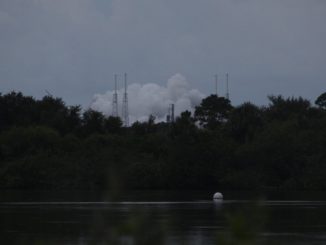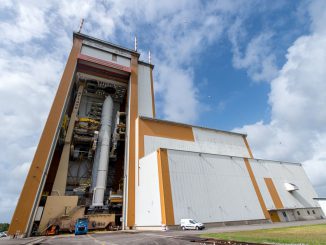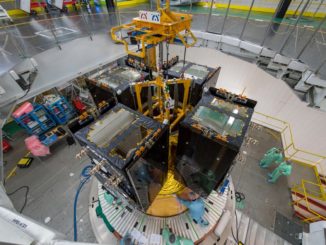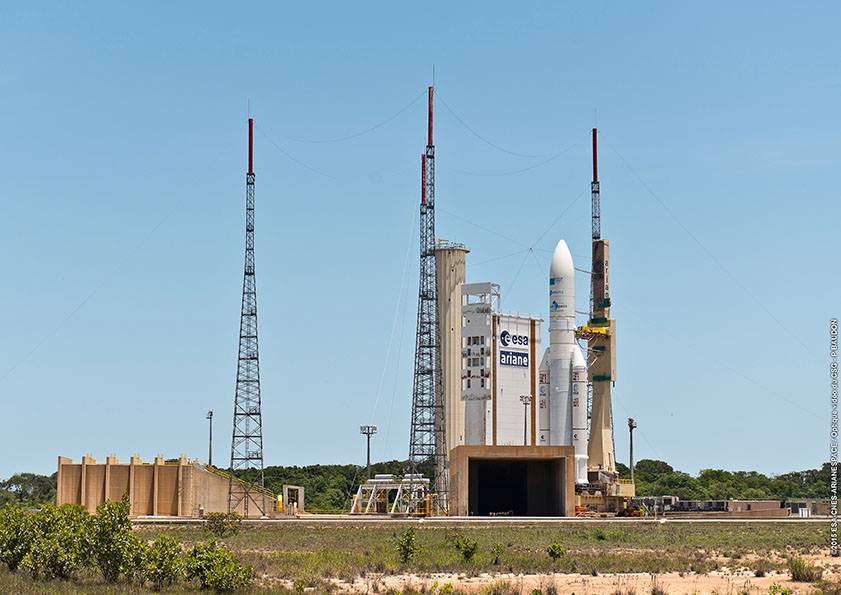
Government enterprises in Australia and Argentina will get a boost Wednesday with the launch of an Ariane 5 rocket from French Guiana with two communications satellites.
An Australian spacecraft named Sky Muster on Wednesday’s Ariane 5 flight will help inaugurate a nationwide broadband system resolved to provide high-speed connectivity to every Australian home and business by 2020.
The other payload nestled inside the nose cone of the Ariane 5 rocket is Arsat 2, Argentina’s second communications satellite tailored for direct-to-home television broadcasts and Internet services.
The 18-story tall Ariane 5 launcher emerged from its final assembly building at the French Guiana space base Tuesday, rolling 1.7 miles tugged behind a 540-horsepower Titan transporter along rail tracks leading to the ELA-3 launch zone just inland from South America’s northern Atlantic coastline.
After arriving at the launch pad, the Ariane 5 and its mobile launch platform was to be connected to ground supplies of electricity, fluids and propellants ahead of the start of the countdown early Wednesday.
Officials target liftoff of the Ariane 5 rocket at 2030 GMT (4:30 p.m. EDT) at the opening of a launch window extending an hour and 45 minutes. Launch is timed for 5:30 p.m. local time in French Guiana.
The countdown is slated to commence at 0900 GMT (5 a.m. EDT), beginning with activations of the rocket’s electrical systems, followed by fueling of the two-stage rocket with super-cold liquid hydrogen and liquid oxygen propellants.
A final computer-controlled countdown sequence begins seven minutes before liftoff, culminating with ignition of the Ariane 5’s Vulcain 2 main engine and two powerful solid rocket boosters.
Shedding its boosters and nose shroud over the Atlantic Ocean, the Ariane 5 will fly east from the European-run Guiana Space Center, and an upper stage HM7B engine will drive the Sky Muster and Arsat 2 satellites into a highly elliptical geostationary transfer orbit 25 minutes after launch.
Sky Muster will release from the top of the rocket at T+plus 27 minutes, 59 seconds, followed less than two minutes later by the jettisoning of the Ariane’s Sylda 5 dual-payload adapter to expose the smaller Arsat 2 spacecraft for separation.
Arsat 2’s deployment is timed for T+plus 32 minutes, 28 seconds, according to a launch kit published by Arianespace, the Ariane 5’s operator and sales agent.
The Ariane 5’s flight computer is programmed to place the satellites in an orbit with a high point of 22,236 miles (35,786 kilometers), a low point of 155 miles (250 kilometers), and an inclination of 6 degrees.
Both spacecraft carry on-board thrusters to boost themselves into circular geostationary orbits over the equator, where their speed will match the rate of Earth’s rotation, allowing the satellites to hover over fixed geographic positions.
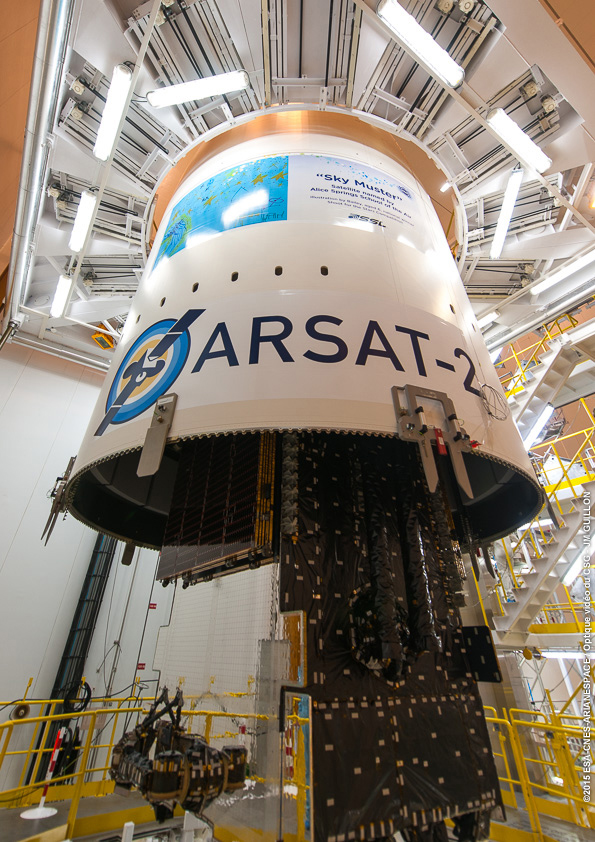
Made in California by Space Systems/Loral, the 14,200-pound Sky Muster satellite is the first of two platforms ordered by NBN Co., an enterprise owned by the Australian government, to round out a national broadband network.
The system will use a combination of terrestrial fiber connections and satellite beams to ensure every Australian citizen access to broadband Internet by 2020.
NBN Co. spent approximately $1 billion in the satellite and launcher purchases. The second NBN spacecraft will fly on an Ariane 5 rocket in 2016.
From their positions 22,000 miles above Earth, the NBN satellites will each broadcast through 101 spot beams covering all of Australia and offshore territories. Users can expect to see download speeds up to 25 megabits per second, and upload rates of 5 megabits per second, according to NBN’s website.
Satellites are needed to connect hundreds of thousands of people living and working in the most remote regions of Australia. Together with terrestrial connections, the national broadband system will eventually reach eight million homes and businesses.
“The launch date is a huge step forward for those living in regional and remote Australia, with more than 200,000 homes and businesses set to be covered,” said Australian prime minister Malcolm Turnbull.
“The NBN long term satellite service will be a game changer for those living in the bush and will help bridge the digital divide currently experienced by many,” Turnbull said in a statement.
Turnbull was communications minister — with a portfolio overseeing NBN — before taking the top post in Australia’s government earlier this month.
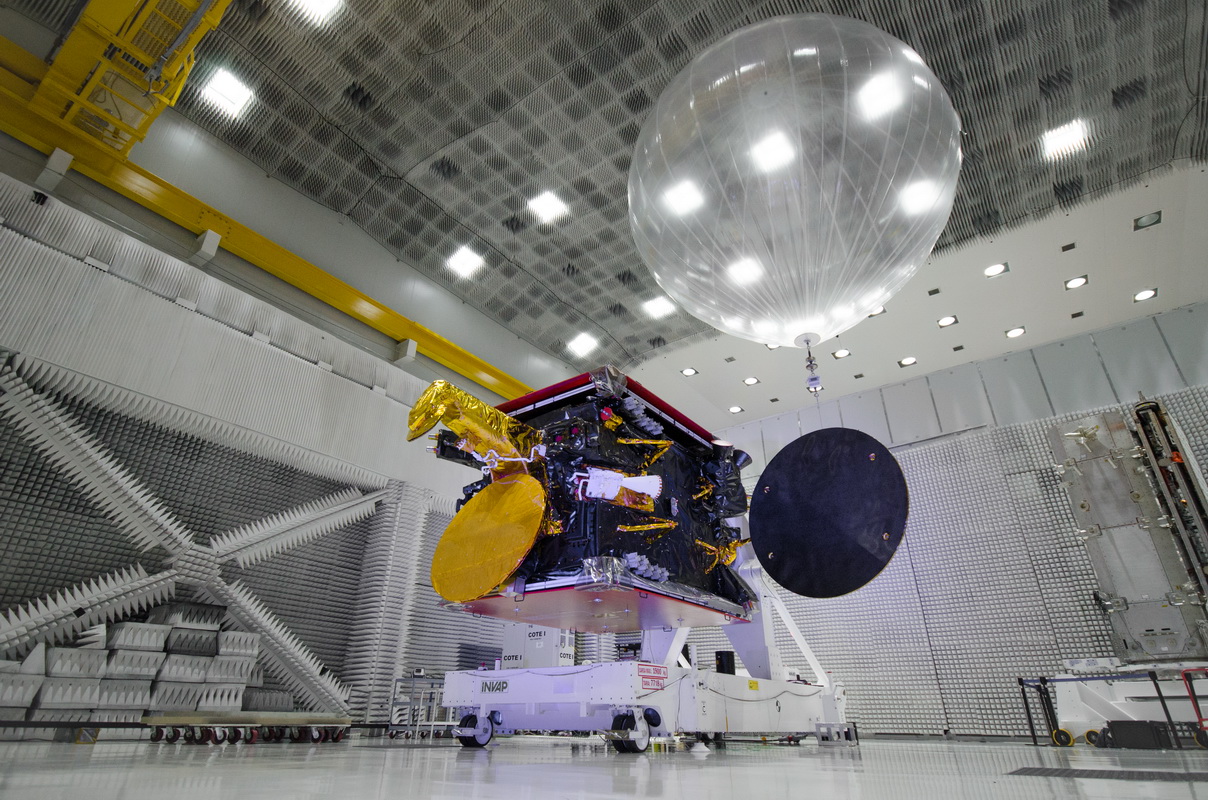
The Arsat 2 satellite riding in the lower berth of the Ariane 5’s payload composite is the second in a series of Argentine communications birds.
Following last year’s launch of Arsat 1, the first large telecom satellite ever built in Argentina, Arsat 2 was built in Patagonia by INVAP, an Argentine high-tech contractor.
Arsat 2 weighs 6,563 pounds with a full load of fuel at launch, and it is heading for a position in geostationary orbit at 81 degrees west longitude. It hosts 26 Ku-band transponders and 10 C-band transponders, covering all of North and South America.
The satellite will support television, Internet, data and telephone services, according to Arsat, Argentina’s national satellite telecom operator.
Email the author.
Follow Stephen Clark on Twitter: @StephenClark1.

